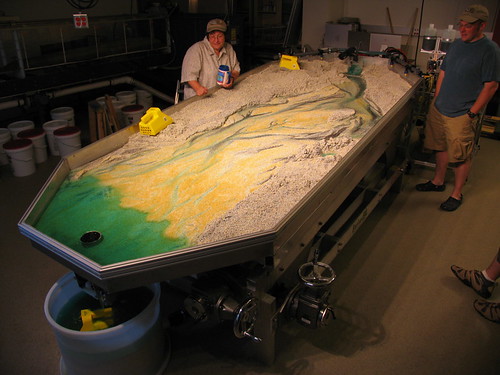You might notice there is open water on either one bank or the other, which is correct - the ice seems to be melting along certain parts of the stream. This might not seem very significant, but it is! Like most things geological, the fun part is learning "why."
Water flows down stream channels, which aren't often very straight [citation needed]. When the water reaches a meander or bend in the stream, physics steps, and a few important things begin to happen.
Firstly, as you can see from the above image, the bank on the outside of the bend is where the incoming water "collides" with the bank, resulting in erosion of the bend (rightfully called the cut bank). As you could imagine, this would cause the outside bend to meander outward even more, creating a sharper bend, which would cause the water to erode the bank even greater, and so on. This is called a positive feedback loop, in which A increases B, and B increases A, which goes on forever until something breaks. Once a bend begins in a river, it will grow until it becomes so big it eventually cuts itself off, usually leaving behind an oxbow lake and other really cool landforms.
 |
| Birth and death of a meander bend, resulting in an oxbow lake |
 |
| Whoever said nobody crosses the same stream twice wasn't kidding |
Secondly, if you imagined the mass of water moving through the stream as a group of runners going around a track, in order for everyone to stay in a group, the person on the outside runs faster than the person on the inside of the turn, as they'd have to run a greater distance to keep up. For the stream, this means that the water flowing along the outside of the bend not only hits the bank more directly, but is also moving faster, which also increases erosion. In contrast, water moving around the inside of the bend slows down. A stream's ability to transport sediment is a result of how fast it is flowing, so the inside of a river bend is where a lot of the sediment is deposited (called the point bar), making it shallow. If you're ever in Alaska panning for gold, this is where the flakes are.
In the end, the different velocities resulting in either deposition or erosion around a river bend means that the channel profile is lopsided. If you were to measure the depth of a river across the channel around a meander bend, it would look like this:
 |
| Cross-section of a stream channel. Note the asymmetrical depth of the river. |
The deepest part of the river is called the thalweg, which is one of my favorite geo-words. It is due to focused erosion from increased stream velocity and the physics of fluids flowing around a bend. When rivers are used as political boundaries, the thalweg is often used to define that boundary. From the air, the thalweg would be drawn like this:
In fairly straight streams, the thalweg is near the middle of the channel, while in very bendy streams it alternates from one bank to the other. This above diagram (specifically the bendy example) is what came to mind when I saw the preferential melting of Minnehaha Creek - the thalweg of the creek is what is melting first. This makes sense, as the water there would be deeper and faster, and therefore more able to transport heat and melt and carry away the ice. In one of the photos, you can even see the thalweg switch banks from one bend to the other:
 |
| First ice melting in Minnehaha Creek is concentrated at the thalweg. |
 |
| The thalweg meanders along the stream to be closest to the cut bank, evidenced by the melted ice. |
This allowed us to create and destroy our own rivers, and see how changing things like slope and water velocity would reshape the stream. It was always very zen to watch. You can really see the concepts I describe above in action with the formation of cut banks and point bars in this time-lapse video.













